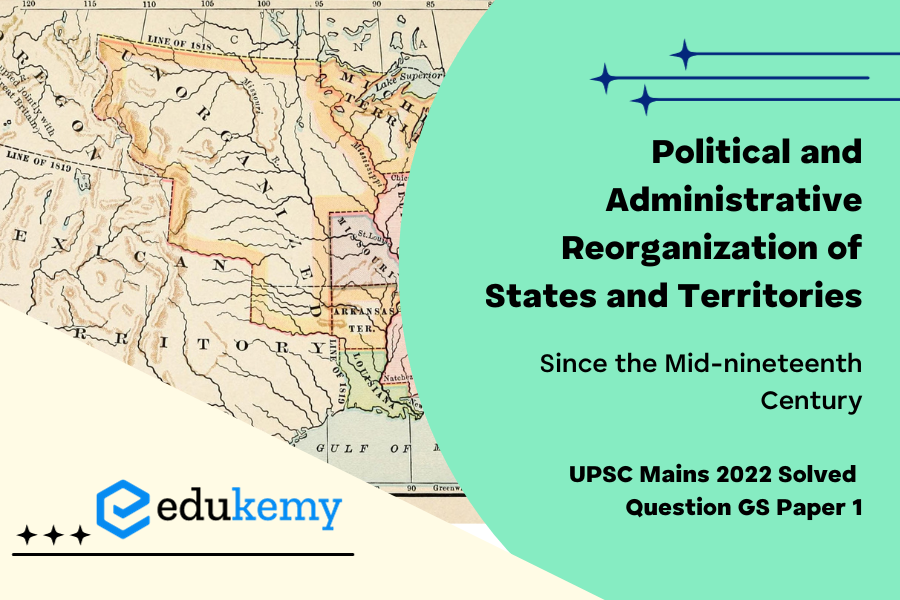The reorganization of states and territories in India has persisted since the mid-nineteenth century, driven by political, linguistic, and administrative considerations. Examples include the States Reorganization Act of 1956, the formation of new states like Telangana in 2014, and ongoing demands for territorial restructuring to address regional aspirations and governance effectiveness.
UPSC Mains General Studies Paper – 1 Mains 2022
UPSC Mains Civil Services IAS Exam Question Paper – 2022
Contents
Answer
Introduction
Early on in the company’s rule, the East India Company began reorganizing the territories in the states they captured, starting with Bengal, Bombay, and Madras Presidency. Since then, reorganization and consolidation of states has been a constant process.
Body
Phase-1 1850’s to 1947:
- After the revolt of 1857, the British government accelerated the process of continuous political and administrative reorganization.
- New presidencies were created (Central Province)
- Several independent states became part of the Chief Administration provinces (Assam, Awadh)
- North-West Frontier Province, was created in 1901 from the north-western districts of the Punjab Province.
- Bengal was partitioned in 1905 on the basis of religion and language.
Phase 2: 1947- 2022:
- In 1950, the Indian Constitution contained a four-fold classification of the states of the Indian Union- Part A, Part B, Part C and Part D States on a political and administrative basis.
- In 1953, the States Reorganization Commission (SRC) under Fazal Ali was constituted to recommend the reorganization of state boundaries.
- Subsequently, the 7th Constitutional Amendment Act was passed which laid out two classifications of units: States and Union Territories.
- Andhra Pradesh became the first state to be formed on a linguistic basis.
- Territories from Portuguese and France: After the acquisition imposed by Mahe, Chandernagore, Karaikal, and Aman, the territories of Daman and Diu, and Goa were either marked as union territories or given the status of neighboring states..
- Shah Commission : Most of the Punjabi-speaking community has shifted to Haryana. Chandigarh served as the Union Territory and is known as the joint capital of Haryana and Punjab.
- Both of these states share many things in common such as universities, high count, and the major components of the power system. Later, Punjab was known as a separate state.
- In 2000 ,The creation of Chhattisgarh, Jharkhand and Uttarakhand was made possible by disintegrating regional boundaries and political territories from within the existing States of Madhya Pradesh, Bihar and Uttar Pradesh, respectively.
- In 2014, Andhra Pradesh Reorganization Act 2014 was passed that carved Telangana State out of Andhra Pradesh.
- Most recently, in 2019 the State of Jammu and Kashmir was reorganized as Jammu Kashmir and Ladakh with UT s status for administrative and security purposes.
- After creating the two Union territories of Ladakh and Jammu and Kashmir, the new political map came into existence which led to reorganization of Jammu and Kashmir.
As our Indian Constitution is a living document, which allows reorganization of states and union territories (Article-3), reorganization of states may remain a continuous process with regard to the evolving nature of political and administrative dynamics.
Conclusion
India’s federal structure is a one-of-a-kind example in which the state has been constantly fiddling with its inner boundaries in order to maintain its unity in diversity.
In case you still have your doubts, contact us on 8792740517.
For UPSC Prelims Resources, Click here
For Daily Updates and Study Material:
Join our Telegram Channel – Edukemy for IAS
- 1. Learn through Videos – here
- 2. Be Exam Ready by Practicing Daily MCQs – here
- 3. Daily Newsletter – Get all your Current Affairs Covered – here
- 4. Mains Answer Writing Practice – here


